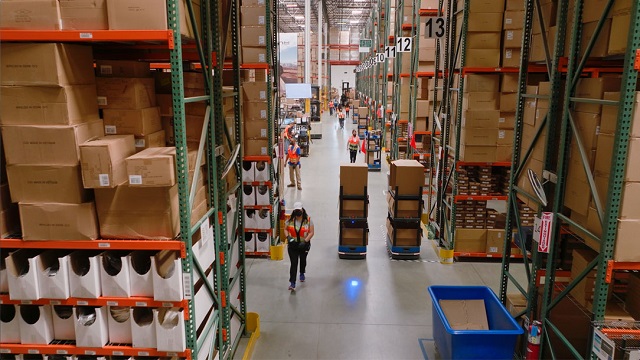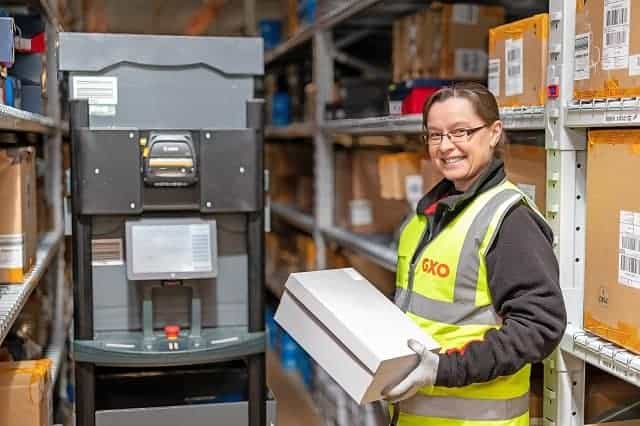A strategic plan is a framework or series of guideposts that keeps an operating plan on the right path to meeting objectives. It defines who you are, where you want to be and how you’ll get there while addressing stakeholders’ concerns and expectations.
According to Harvard Business Review, an estimated 67% of business strategies fail due to poor execution, making effective logistics planning and strategy paramount to your company’s success. A comprehensive logistics strategy should encompass strategic, operational and tactical levels of logistical planning as well as the four main pain points in the supply chain, including facility locations, customer service levels and inventory and transportation decision-making.
What are the benefits of logistics planning?
The primary objective of any logistics strategy is to deliver the right products to the right customers at the right time and at the least possible cost. An effective logistics strategy can help your company minimize investments and other costs by defining the service levels at which your organization is most cost-effective. The result is a win-win situation: your company benefits from cost efficiency, and your customers get what they need, when they need it, boosting customer satisfaction.
In a changing environment, logistics planning minimizes risk by enabling companies to anticipate change and develop strategies to adapt to those changes. Supply chains are always in a state of flux, so many companies develop logistics strategies for specific product lines, geographic regions or customer segments, enabling them to adapt to market changes impacting one region or business line while maintaining efficiency across others.
What are the three major aspects of strategic logistics planning?
The three major aspects of strategic logistics planning include long-term goals and the means and process for achieving those goals.
- Long-term goals: Long-term goals include customer satisfaction, your company’s competitive advantage and supply chain management.
- Means: The means for achieving your long-term goals include delivering value and customer service.
- Process: The process for achieving your company’s long-term goals includes how you’ll execute your logistics strategy, as well as anticipating and managing change and relating each element of your logistics strategy to the company’s overarching business objectives.
A strategic logistics plan typically covers five or more years. On a more granular level, a strategic logistics plan should include the following elements:
- An overview of the logistics strategy in general terms and how it relates to other business functions.
- Logistics objectives and how each relates to cost and service for the product and the customer.
- Descriptions of each strategy that will support the overall strategic logistics plan. These strategies should include inventory and warehousing, order processing and fulfillment, transportation and customer service.
- A breakdown of each logistic or operational plan including timing, costs for implementation and their impact on other business functions and the business as a whole.
- Forecasts of requirements for the workforce, capital and any other necessary assets.
- A financial statement that describes capital requirements, operating costs and cash flow in detail to paint a clear financial picture for executives and stakeholders.
- A business impacts analysis that details anticipated impacts on profits, customer service and other business functions.
Aligning your logistics goals to broader business objectives is a crucial component of an effective logistics strategy. According to Trissa Strategy Consulting, 63% of successful companies have every business unit aligned to their overall corporate strategy, from IT and human resources to marketing and supply chain management. Likewise, 64% of successful companies build their budget around their strategy, making elements such as financial forecasts, capital requirements and analysis of operating costs and cash flow vital to your company’s success.
Logistics planning and strategy tips
As the biggest players in fulfillment, distribution and omnichannel retail continue to push boundaries, logistics and planning strategists are forced to innovate. Luckily, the current movers and shakers of the logistics and supply chain world are all too happy to dole out sage advice in the form of blog posts, interviews, podcasts — you name it. Seeing this, we decided that it would be helpful to compile a curated list of 50 of the best tips on logistics planning and strategy that we could find.
The logistics tips below cover everything from unified supply chains to automated collaboration integration and beyond. Click on a category below to jump to the section that fits your interests best:
- Planning tips to unify supply chains
- Logistics strategies for streamlined fulfillment
- Integrating automated collaboration
- Logistics personnel and supplier management pointers
- Tips for improving customer experience
Planning tips to unify supply chains

1. Create an adaptive unified buying process. “If you look at the typical buying process, it is bifurcated based on geography. If I am going to buy goods from this geography, then I use this process. If I am going to deal with these partners, then I use this process. Another geography may call for another process and a different technology. Our point of view is to ask our clients what it is that you want to buy and we will unify those processes across the geography, those partners and those technologies so that it becomes transparent to the user.” — Sue Welch, CEO of TradeStone Software, as quoted in A Unified Supply Chain, Forbes; Twitter: @Forbes
2. Make room for collaboration. “With better communication tools present, businesses can also build their collaborative rapport across the supply chain to eliminate confusion. Traditionally, most supply chain members are solely concerned with their own performance and output. While it’s certainly important for each stakeholder to ensure they’re meeting deadlines and turning in quality performance, silos along the supply chain make it difficult to address inefficiencies in any meaningful way.
“Many supply chain members simply pass the buck. Many times, not fully understanding how their own activity connects to other teams can breed a flippant attitude. Companies can boost holistic supply chain management by working with all stakeholders to develop a roadmap for consistent, continuous and collaborative improvement.” — 4 Ways to Make Supply Chain Management More Efficient, Lightwell; Twitter: @lightwellinc
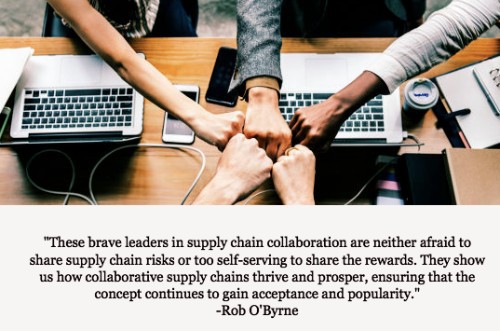
3. Take a generous approach to your supply chain collaboration. “As more organisations recognise the need to collaborate, a whole new culture is evolving. This is why collaboration has become such a familiar buzzword in the supply chain world. But true collaboration is not an easy state to arrive at. Boundaries of mistrust must be broken down and conflicting objectives must somehow be transformed into aligned goals.
“Steady progress is being made though, aided by web technology that helps companies share information, systems integration for seamless supply chain handoffs, and perhaps most importantly, by the fearlessness of pioneering organisations. These brave leaders in supply chain collaboration are neither afraid to share supply chain risks or too self-serving to share the rewards. They show us how collaborative supply chains thrive and prosper, ensuring that the concept continues to gain acceptance and popularity.” — Rob O’Byrne, An Introduction to Supply Chain Collaboration, Supply Chain Secrets; Twitter: @scs14official
4. Make your supply chain center of excellence (CoE). “Although it is entirely possible to create a virtual center of excellence by having experts across the company collaborate electronically, they often can be more effective if they work together in the same location. One reason is that doing so can improve communication and collaboration. For example, supply chain design is extremely complex, and the analyses lend themselves to sitting side-by-side and graphically depicting and explaining ideas.
“A centralized group can also help to resolve another common concern: it’s hard for an expert to have credibility across the company when he or she is remote and attached to a particular business unit. And finally, a centrally located department promotes the most efficient use of a limited talent pool, allowing experts to focus on the CoE’s mission rather than having to juggle responsibilities on both a business-unit and a corporate level.” — Jonathan Whitaker, How to Create a Supply Chain Center of Excellence that Works, Supply Chain Quarterly; Twitter: @TheQuarterly
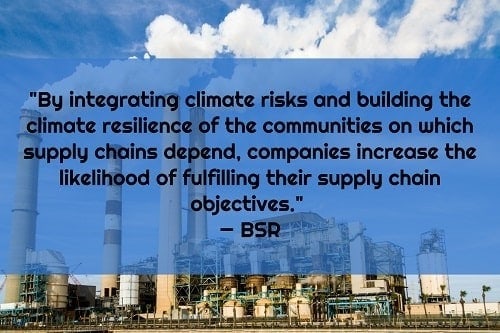
5. Devise a model that supports environmental sustainability. “BSR recommends that companies address climate risks in their supply chains by focusing where they have the greatest impact and greatest influence and taking several steps:
- Consider a broad range of climate risks and prioritize parts of the supply chain that are most at risk.
- Implement supply chain actions, including with internal procurement teams, with suppliers and through broader collaboration, and develop measurable targets for these efforts.
- Evaluate the impact of supply chain actions and adjust programs and goals over time.
“By integrating climate risks and building the climate resilience of the communities on which supply chains depend, companies increase the likelihood of fulfilling their supply chain objectives.” — BSR, as quoted in How to Integrate Climate Change Risks and Opportunities into Supply Chain Management, SupplyChain247; Twitter: @supplychain247
6. Understand the effect that supply chains have on their companies. “As companies have looked to spread their production around the globe to cut costs and build their customer base, effective supply chains have been found to often raise efficiency and assure products reach their end user as quickly as possible.
“Businesses don’t compete; supply chains compete. Now, supply chain officers are getting in on the strategic decisions that are being made.” — William Verdini, associate professor and chairman of the Supply Chain Management Department at Arizona State University’s Carey School of Business, as quoted in The Importance of Education in Supply Chain Management, Reliable Plant; Twitter: @NoriaCorp
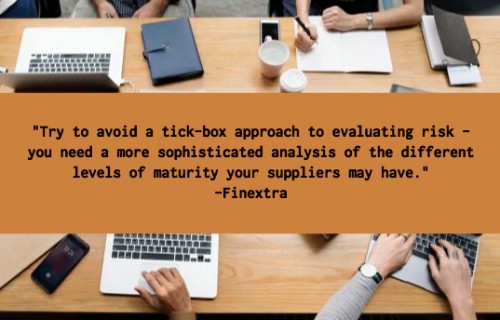
7. Know when you are inviting risk into your supply chain. “Get to grips with the risk each supplier brings to your business — how credible is each of the organisations on which you depend? By getting to grips with issues such as suppliers’ creditworthiness, payments history, data security and their own supply chain resilience, you can build a much more in-depth picture of any threat they may propose — and manage the danger accordingly. Try to avoid a tick-box approach to evaluating risk – you need a more sophisticated analysis of the different levels of maturity your suppliers may have.” — Seven Ways to Boost Supply Chain Resilience, Finextra; Twitter: @finextra
8. Acquaint yourself with the dreaded ‘worst case scenario’. “Building on a well designed product and supply chain, it’s time to plan for the inevitable — disaster! Whether natural or otherwise, Murphy’s Law states it’s going to happen, so you must be ready for it when it does. One of the keys to effective supply chain management is a control tower, essentially a single place where you can go to see everything that’s happening, evaluate your response and execute upon it. NetSuite has launched a supply chain snapshot feature that’s a central part of any control tower that shows all of your inventory and related transactions with the ability to filter by subsidiary, location, etc.
“Users can easily now look at your global or regional supply situation and quickly source alternates when required, but the key here is to practice your response. Using a sandbox account to plan out some simple and worst-case scenarios and discussing the best ways to resolve them and how those should be communicated internally and externally will make it easier to execute an alternate plan when it’s required.” — Gavin Davidson, Design, Plan Execute, and Support–A Supply Chain Evaluation Guide, NetSuite Blog; Twitter: @NetSuite
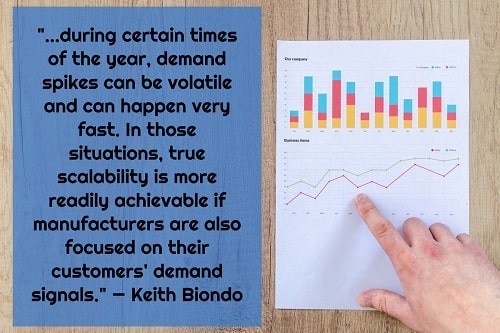
9. Study the needs of your supply chain in order to make informed predictions. “Many manufacturers practice demand-driven logistics, meaning they are focused on their customers’ buying signals. The idea is to have aligned their enterprise to seamlessly respond to those signals. That’s an extremely efficient way of reducing total logistics costs while providing optimal customer service.
“However, during certain times of the year, demand spikes can be volatile and can happen very fast. In those situations, true scalability is more readily achievable if manufacturers are also focused on their customers’ demand signals.” — Keith Biondo, Publisher of Inbound Logistics, Three Logistics Lessons Black Friday Can Teach Manufacturers and the Supply Chain, Thomas; Twitter: @Thomasnet
10. Reassess your demand forecasting model. “Demand forecasts should predict two outcomes: the expected demand and how much uncertainty there is in that prediction. The need to predict demand is fairly obvious. It drives most supply chain planning activities. And you probably measure the efficacy of your tools and processes with well-known forecast accuracy KPIs.
“But the need to predict forecast uncertainty is not nearly as clear, and you probably make some gross assumptions about demand uncertainty and just assume they are accurate. By the way, if you don’t know whether or not you are making these assumptions, then we can pretty much guarantee that you are.” — Jeff Bodenstab & Stefan de Kok, What’s Wrong with Demand Forecasting?, Supply Chain 247; Twitter: @supplychain247
Logistics strategies for streamlined fulfillment
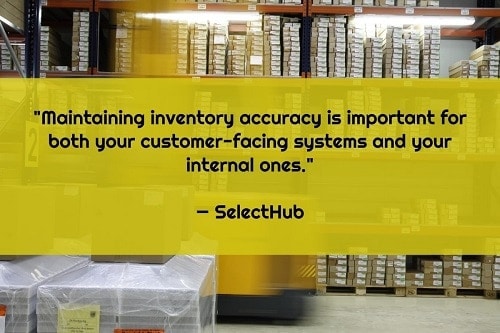
11. Maintain and expand your inventory management strategies. “Maintaining inventory accuracy is important for both your customer-facing systems and your internal ones. As we just mentioned, updating your inventory count in real time ensures that your customers can’t order products unless they’re in stock. At the very least, they should see a message indicating that the products are out of stock before they make the purchase. This is just good customer service.
“As for your internal systems, real-time inventory management helps you manage your fulfillment warehouses. This allows you to keep tabs on the inventory levels of your various products, helping you decide if you need to ramp up your production of those products or decrease it. After all, one of the more difficult aspects of managing warehouses is what to do with excess inventory, so you need to reduce it as much as possible.” — 5 Strategies for Streamlining Order Fulfillment, SelectHub; Twitter: @SelectHub
12. Reassess the value of your 3PL provider. “Third party logistics (3PL) providers offer solutions in warehousing, packaging, assembly and distribution under one roof, so you can leave some or all of the order fulfillment to supply chain experts.
“A 3PL can provide a range of fulfillment services, from setup, to shipping, to customer service. Most can integrate with existing e-commerce systems, manage inventory, optimize transit time, process returns and claims and provide the data you need on your unique KPIs. You don’t need to invest in warehouse space or expanded technology, and you don’t need to hire and sustain more internal employees.” — How to Create a Fulfillment Strategy that Delights Customers, Saddle Creek Logistics Providers; Twitter: @saddlecreeklog
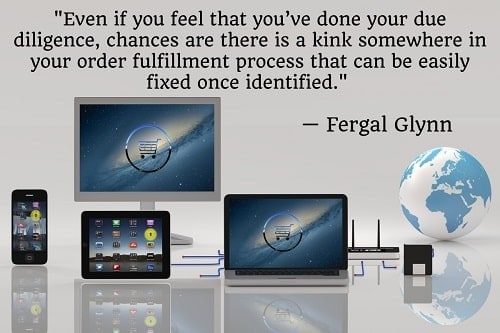
13. Promote your visibility. “Because demands in the e-commerce sector are ever-changing, it’s important that you increase your supply chain visibility at every corner. This means that you utilize tools to track production, orders and product shipments in order to get a better idea of what might be hurting — or helping — your unique processes.
“Even if you feel that you’ve done your due diligence, chances are there is a kink somewhere in your order fulfillment process that can be easily fixed once identified. Set aside the time, funds and book your most thorough employees to do a review, then reap the rewards once you’ve made plans to remedy your trouble spots.” — Fergal Glynn, 5 Ways to Streamline the Order Fulfillment Process, 6 River Systems; Twitter: @6riversystems
14. Evaluate your warehouse manager’s pick and pack processes. “Operations management offers a large field of contenders, but this final element has the greatest potential to impact efficiency, productivity and costs. For many companies, the picking process represents as much as half of the operating cost of the warehouse. Moreover, pick-n-pack is one aspect that is entirely under your control when it comes to having a positive impact on your customers. You can’t control the weather or the traffic or any number of factors that happen outside your warehouse doors, but you can track the efficiency of the picking process that takes place under your roof.
“By keeping an eye on these warehousing metrics, you can map out an error-resistant fulfillment process that moves from order to delivery as efficiently as possible. That, in turn, will help to drive customer satisfaction and loyalty to fuel growth. Sure, you may need to expand your warehousing space, but that’s a good problem to have, given the alternatives.” — 7 Metrics You Need to Streamline Your Warehousing Processes, Aero Fulfillment; Twitter: @AeroFulfillment
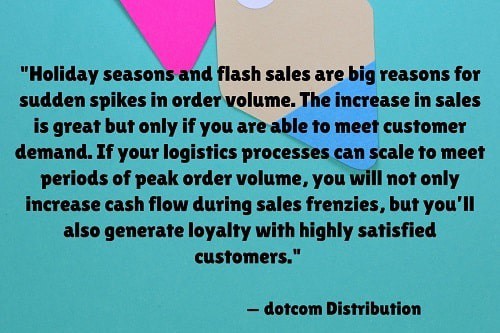
15. Incorporate scalable processes into your logistics strategy. “Holiday seasons and flash sales are big reasons for sudden spikes in order volume. The increase in sales is great but only if you are able to meet customer demand. If your logistics processes can scale to meet periods of peak order volume, you will not only increase cash flow during sales frenzies, but you’ll also generate loyalty with highly satisfied customers.” — A Simple Guide to Better eCommerce Fulfillment and Logistics, dotcom Distribution; Twitter: @DotcomDist
16. Take a fresh look at your omnichannel fulfillment. “Innovation is crucial for expanding the current footprint of omni-channel fulfillment. While ARC has outlined the five key applications for executing seamless fulfillment, companies need to continue to look at new technologies and innovations. This is especially true for the last mile. Crowdsourced options for delivery are a cost-effective manner for home delivery, yet these solutions are still in the infancy stage.
“Many companies are waiting to see how these companies pan out, but more emphasis needs to be placed on making bold moves with high reward potential. This indicates there are a lot of white spaces out there that can be filled by suppliers. This can be accomplished by new solutions or acquisitions.” — Chirs Cunnane, Omnichannel Fulfillment: Strategies for Success, Logistics Viewpoints; Twitter: @logisticsviewpt
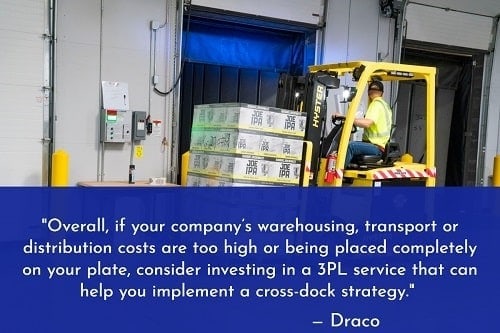
17. Consider implementing cross docking procedures. “Within cross docking lies many tactics in how to make it all work to your benefit. If you are a retailer that sells various types of goods, cross docking can use ‘consolidation’ which would take small shipments and compile them into one large transport. Another tactic is when a major retailer that needs to distribute a large amount of product to various stores, but orders the supply in one large bulk. You can ‘deconsolidate,’ which would allow this large bulk of supply to be fed into many trucks at one time, thus lowering the amount of stops that would have to be made by the supplier.
“In the end, cross docking is a logistical method that calls for perfect timing and procedure but reaps the benefits of lowering overhead costs and streamlining turn around time. What does this mean for you? Well, it could boost your bottom line and shorten lead-time. For your customers it could mean lower retail prices, always-stocked shelves and shipments being on time. Overall, if your company’s warehousing, transport or distribution costs are too high or being placed completely on your plate, consider investing in a 3PL service that can help you implement a cross-dock strategy.” — Streamline and Build Efficiency Through Cross Docking, Draco; Twitter: @dracoindustries
18. Weigh your costs against your customer experience. “The order fulfillment process needs to be designed around the customer, but within the limits of the firm’s business and marketing Although many managers consider order fulfillment to fall within the role of the logistics function, it is the integration with other functions in the firm and other firms the supply chain that becomes key in defining order fulfillment as a supply chain process.
“The team also needs to understand the firm’s order fulfillment budget. That is, determining how much is acceptable to spend on fulfilling the order. A firm might be able to most quickly deliver a product to the customer with an express air shipment, but the costs associated with that policy erodes profits and could be unacceptable. Likewise, financial issues might dictate a minimum order size or something about the selling terms. Throughout the design of the fulfillment process, the team needs to tradeoff the costs of the solution with the benefits to the customer and the impact on the financial performance of the firm, and its customers and suppliers.” — Keely L. Croxton, The Order Fulfillment Process, The Ohio State University; Twitter: @OhioState
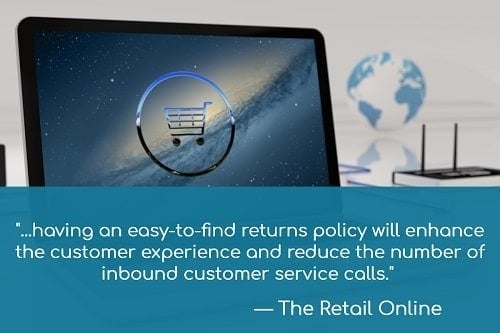
19. Be upfront about your returns policy. “According to a comScore survey of 3,100 U.S. online shoppers conducted in February, 63 percent of those surveyed said they look for a website’s returns policy prior to making a purchase, and nearly two-thirds (62 percent) said they’ve returned a product they purchased online. Half of customers who plan to return a product visit that retailer’s website to find its returns policy. As a result, having an easy-to-find returns policy will enhance the customer experience and reduce the number of inbound customer service calls.
“What’s more, a clear returns policy increases the probability of recommendations and repeat business from online shoppers, as almost half of the respondents said they’d be likely to shop more often with a retailer or recommend a retailer to a friend if the retailer has a lenient and easy-to-understand returns policy.” — The Retail Online, 7 Operations and Fulfillment Tips to Boost Efficiency, TotalRetail; Twitter: @MyTotalRetail
20. Revisit your item details and product pages. “Do you have all the available product details, photos and inventory? Customers want to know as much about a product as they can find, since when they go in the store they have the opportunity to see and feel the things they buy. They’re placing an awful lot of trust in you by buying something they can’t see. So give them more item details and product information than they ask for. It’s better to have too many than not enough — it helps consumers have confidence in making a purchase from you.
“Also, it’s a good idea to make sure your inventory information is indicated on the e-commerce website and is correct, perhaps down to the local store level. When people see you have a certain item on your website, they’re trusting you to have it in stock and will send it to them. They don’t want to get to the store to pick up their BOPUS order just to find out their order isn’t complete. They don’t want to receive an email days after they place their order informing them that the item is on backorder. That’s a quick way to lose a sale and a long-term customer.” —Brandon Pierre, Eight Ways to Improve E-Commerce Order Fulfillment, SPS Commerce; Twitter: @SPS_Commerce
Integrating Automated Collaboration
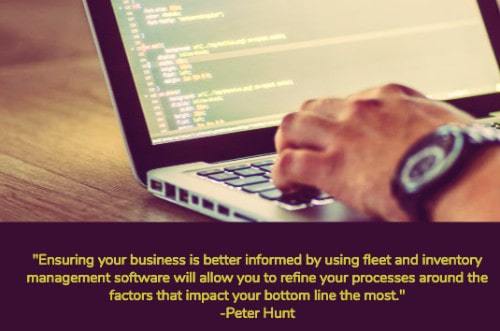
21. Upgrade your manual systems to automated ones. “In the digital age, there are a number of ways you can automate the logistics process, including tracking and monitoring each delivery. These systems take the guesswork out of planning your supply chain by reporting the raw data without bias. Ensuring your business is better informed by using fleet and inventory management software will allow you to refine your processes around the factors that impact your bottom line the most.” — Peter Hunt, Five Tips for Managing Your Logistics More Effectively, Supply Chain Digital; Twitter: @SupplyChainD
22. Educate your company on the benefits of logistics management software platforms. “A growing number of systems and apps on the market help distributors, warehouses, retailers and other companies optimize the daily comings and goings of products and inventory. Through the use of cloud-based technologies, teams can now access real-time insights and vital information to collaborate with other team members, partners and customers around the world.
“Amazingly, this can often be done from a single logistics management software platform that serves to handle your most pressing shipping, financial and HR figures. Depending on the nature of your business, there are several options that can bring order to your chaos.” — Fergal Glynn, 50 Best Logistics Management Software Platforms, 6 River Systems; Twitter: @6riversystems
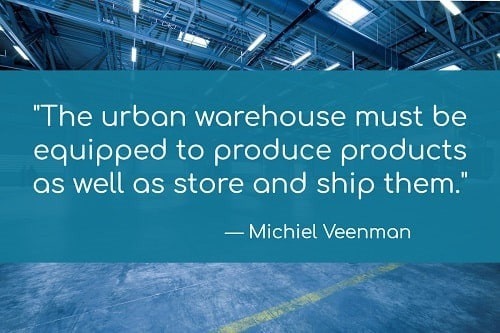
23. Think about how your warehouse might look in 2030. “The urban warehouse must be equipped to produce products as well as store and ship them. With greater customization on the horizon and the continuing maturation of 3D printing technology, the urban distribution center will be well positioned to ‘print’ products on demand and then package and deliver them just as they do products from inventory.” — Michiel Veenman, Envisioning and Planning the Future Warehouse of 2030, Supply Chain 247; Twitter: @SupplyChain247
24. Bolster your WMS with other helpful pairings. “In automated environments, WMS often work alongside warehouse control systems (WCS) that manage the routing of containers as they traverse the material handling equipment, and warehouse execution systems (WES) which often have basic task management capabilities but not the level of control or optimization of a WMS.” — Matt Butler, Warehouse of the Future: Adopting Automation in Your Supply Chain, BlueYonder

25. Cut down on sluggish production times by identifying your operation’s repetitive tasks. “The four primary benefits of warehouse automation are: Reduced labor costs, increased operational efficiency, increased workplace safety and the ability to address labor availability concerns.
“The secret behind these results? Identifying repetitive tasks or unnecessary movements of resources or inventory that can be eliminated or conducted more efficiently, at a lower cost, with less labor, more accurately and in less time.” — Warehouse Automation Guide, Conveyco; Twitter: @Conveyco
26. Create an end-to-end warehouse testing plan with the help of strategic automation. “Overall, the primary focus of testing should be on the end-to-end ETL process. This includes validating the loading of all required rows, correct execution of all transformations and successful completion of the cleansing operation. The team also needs to thoroughly test SQL queries, stored procedures or queries that produce aggregate or summary tables. Finally, with digital transformation initiatives focusing on delivering exceptional customer engagement, it is becoming increasingly critical for the test team to design and execute tests that accurately mirror the customer perspective.” — Wayne Yaddow, Building an End-to-End Data Warehouse Testing Strategy and Test Plan, DZone; Twitter: @Dzone
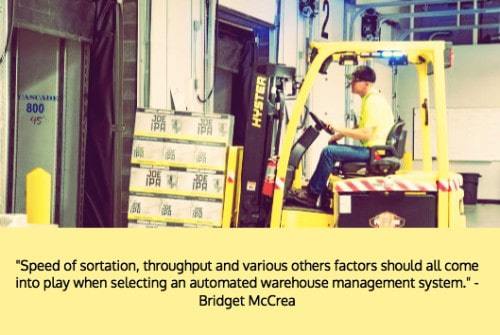
27. Only purchase automation that complements your needs and/or goals. “Speed of sortation, throughput and various others factors should all come into play when selecting an automated warehouse system. If, for example, your company needs to be able to process 250,000 units per day, then that benchmark should be factored into your purchase decision.” — Bridget McCrea, 7 Steps to Take Before You Install an Automated Warehouse System, Modern Materials Handling; Twitter: @modernmhmag
28. Begin making use of shipping integrations. “Integrated shipping carriers allow your warehouse team to instantly print shipping labels and manifests, whilst automatically alerting carriers that a shipment needs to be charged for and picked up. To cover all areas, you should ensure that the shipping integration you use also has the ability to circle back around to your central management system to reflect the current status of the order, and automatically send out tracking references to customers.” — Justine Cross, Five Warehouse Automation Technologies and Tips, ERP Focus; Twitter: @erpfocus
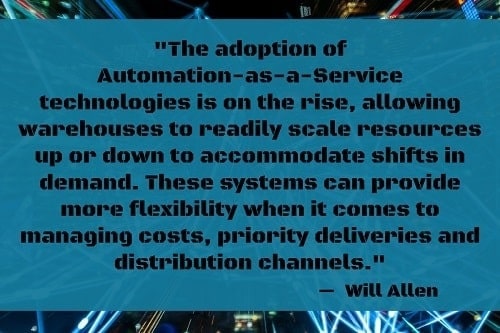
29. Consider Automation-as-a-Service. “Balancing supply and demand is as important as ever, but doing so requires flexibility. The adoption of Automation-as-a-Service technologies is on the rise, allowing warehouses to readily scale resources up or down to accommodate shifts in demand. These systems can provide more flexibility when it comes to managing costs, priority deliveries and distribution channels. For instance, companies like 6 River Systems allow warehouse operators to rent collaborative robots during a peak period and return them when demand returns to baseline levels, avoiding major investments in equipment that would sit idle during non-peak periods.” — Will Allen, 6 ways logistics technology is impacting warehousing, 6 River Systems; Twitter: @6riversystems
30. Swap out your heavy-duty scanners, for inexpensive, lightweight devices. “In the past, only large expensive rugged devices seemed fit for purpose. However, it has become all-too-natural to ask how smartphones, Android devices, wearables, etc. could be used as a cheaper, more familiar alternative to bulky and expensive RFID guns that were a fixture in most warehouses.” — Tim Payne, The Evolving Warehouse and Future Trends, Explore WMS; Twitter: @ExploreWMS
Logistics personnel and supplier management pointers

31. Communication with the entire staff is one of the building blocks of productivity. “Communications is very important to this phase of your business. Schedules must be current, and warehouse staff and transportation personnel need to be aware of scheduling changes at all times. Your customers also require attention. This is not only for his own facility’s scheduling, but it’s necessary for your company to maintain a strong customer service presence and preserve the reliability on which your customers count.” — Tips for Improving Your Outbound Logistics, Liquidation.com; Twitter:@liquidation_com
32. Develop a social awareness that your supply chain can respect. “‘To be a good supply chain leader, you have to be able to span boundaries. To be successful in supply chain management, you have to have social awareness, and be accommodating and flexible to lead change that transcends boundaries.” — Chuck Taylor, CEO and executive vice president of ServiceCraft Logistics, as told to Leslie Hansen Harps, What Makes a Logistics Leader?, Inbound Logistics; Twitter: @ILMagazine

33. Be a sounding board. “A strong operations leader understands that employees are a valuable resource and can effectively communicate with operations staff. That not only means delivering the hard facts and providing thoughtful and constructive feedback, but listening to empowered employees who are part of the same team.” — 5 Management Traits of an Operations Manager, The University of Scranton; Twitter: @univofscranton
34. Take a partnership approach to supplier management. “The following three principles, if followed, will help your company graduate toward best-in-class supplier performance management.
“1) When selecting suppliers, ask not only what they can do for you, but also how realistic it will be to work with them for mutual benefits.
“2) After relationships have begun, look for mutually beneficial ways to reduce total supply chain cost or maximise profitability.
“3) By all means, agree penalties to discourage lackluster supplier performance, but reserve their application for when collaborative efforts fail. Even then, you should be sure your own organisation is not at fault, before leaning on suppliers with charge-backs or other penalties.” — Rob O’Byrne, 4 Tips for Effective Supplier Performance Management, Logistics Bureau; Twitter: @LogisticsBureau

35. Make talent development a priority. “Succession planning and team training are the foundation of any procurement or logistics operation. Getting in someone that knows how to identify talent, internally and externally, will help the operational business in many areas. The right person will know how to attract the right calibre of employee, whether that be graduates or experienced hires, by structuring development plans implementing innovative initiatives to keep them engaged, while developing their careers.” — 10 Skills Your Logistics Team Needs to Know, Michael Page Logistics; Twitter: @MichaelPageUK
36. Add value to all facets of your team. “The team is an essential aspect of an organization that is responsible for the growth. Whether it’s the delivery guy or the warehouse manager, everyone should be perfect in their respective field of work. For this, you need to invest in proper training of the employees. Regular training workshops keep the employees updated with the latest trends in the logistics industry. This helps in increased efficiency and satisfaction of the clients.
“A logistics manager with impeccable interpersonal skills is crucial for the organization. There are times when the things don’t work according to the plan. In this situation, instead of panicking, you need a reliable person who can sort out the issues with utmost efficiency. Moreover, the manager should have authoritative contacts in the industry. This can be beneficial in tapping the business opportunities.” — Adam Robinson, 6 Important Tips for Effective Logistics Management, Cerasis; Twitter: @Cerasis

37. Set mutually-beneficial goals with your suppliers. “Common challenges and shared successes will drive reciprocal support. A win-win orientation is the key to promoting risk reduction, technology innovation, system integration and cost effectiveness. When suppliers and companies focus on communal benefits, this increases both organization’s market agility and competitiveness. Creating a network of suppliers who support each other and leverage their unique abilities will drive operational innovation and process improvement activities. Shared information resources will promote continuous growth and minimize risks. Regular benefits measurement, executive oversight and strategic coherence will ensure organizational success.” — Tim Brittingham, Director of Continuous Improvement at RBW Logistics, The Secrets to Successful Supplier Relationship Management, RBW Logistics; Twitter: @rbwlogistics
38. Protect yourself by evaluating your supplier’s liability and insurance needs. “Use of any external supplier of products or services, either upstream or downstream, requires an evaluation of potential liability exposure. Every contract must address the three-legged stool of protections: limitation of liability, indemnification and supplier insurance. The last requires special administrative attention, but is frequently under-managed.
“Suppliers should carry insurance for two reasons. First, it protects them from legal and financial exposure that could limit their ability to support contractual commitments. Second, it provides a buffer of protection to the procurement organization against direct or indirect claims from suppliers or other third parties that may be affected by contracted suppliers’ actions or inactions. If a contracted supplier is allowed to utilize key subcontractors in the performance of services, those firms must also be required to provide insurance coverage compliance.” — Mark Trowbridge, Five Techniques to Manage Supply Chain Risk, Supply Chain Management Review; Twitter: @SCMR

39. Provide your team with accessible benchmarks. “Getting everyone on your team involved is crucial to improving overall supply chain management. Each person has a unique part to play in the health and success of your company, and setting goals can help everyone get on the same page.
“Go beyond the traditional metrics of capital, service and cost and determine some aggressive key performance indicators (KPIs) that are necessary for helping your supply chain improve. Sit down with your executive team and really brainstorm what metrics matter to your business. Don’t just include something because you think it ‘should be’ measured; forcing KPIs that don’t matter to your business goals are just going to frustrate everyone and take away from the opportunity to work toward effective goals.
“No matter what you choose to do, improving your business’s supply chain management is an important factor in your overall success. Getting serious about measuring the right things and analyzing data that matters to your business is going to help your business grow and thrive for years to come.” — 3 Tips for Improving Supply Chain Management, Cannon Hill Logistics; Twitter: @cannonhilllogis
40. Create a “middle ground” for your suppliers. “Spend equal time aligning incentives and penalties. It is natural to worry about the worst case, such as if a shipment is not received and a plant grinds to a halt. Conversely, the extra value created when production and asset utilization is optimized should be the basis of improving the value proposition for both parties.” — Dave Blanchard, 10 Strategies for Managing Suppliers, Industry Week; Twitter: @IndustryWeek
Tips for improving customer experience
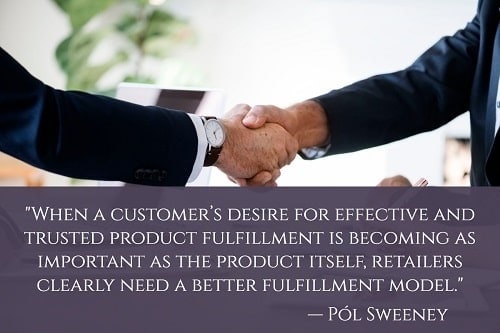
41. Remain open to change. “When a customer’s desire for effective and trusted product fulfillment is becoming as important as the product itself, retailers clearly need a better fulfillment model. Retailers need to be able to present service and costed delivery options immediately — and that has to be based on real–time information throughout the supply chain, from last-mile services through to the wider distribution network and end suppliers. Critically, that information has to be available to the retailer in such a way that costs can be automatically assessed and a price dynamically created and presented to the consumer to ensure the service option is financially viable.” — Pól Sweeney, Vice President Sales at Descartes Systems UK, Delivering an End-to-End Customer Experience, Supply Chain Digital; Twitter: @SupplyChainD
42. Award transparency to your customers. “Instead of simply getting goods from point A to point B, logistics providers need to think of themselves as a strategic asset. Making this shift means thinking through the big picture value for customers.
“It’s not about claim rates and transit times. It’s about giving customers insights into their businesses which can drive improved performance, savings and value for their own clients. These insights, in turn, shape the kinds of services that shippers will demand moving forward, which provides an opportunity to control the customer experience far beyond today’s transactional environment.” — Zen Newman, A Technology-Driven Customer Experience is the Future for the Logistics Industry, Capterra; Twitter: @capterra
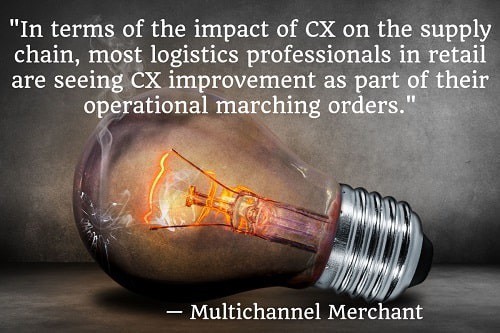
43. Follow the CX (customer experience) trends. “In terms of the impact of CX on the supply chain, most logistics professionals in retail are seeing CX improvement as part of their operational marching orders. Eighty-three percent of respondents said CX is now a company-wide goal, and they’re feeling the pressure to improve it.
“According to the survey, conducted by eft Supply Chain & Logistics Business Intelligence, over 83% of respondents said customer experience is a company-wide goal, with nearly 56% reporting CX measurement is key to their operational decisions. Two-thirds of respondents said gaining greater control of CX is crucial or very important to their approach to delivery.” — Customer Experience a Key Aspect of Retail Supply Chain Operations, Multichannel Merchant; Twitter: @mcmerchant
44. Keep customers up-to-date with shipping and product replenishment alerts. “In addition to tracking capabilities, up-to-date alerts keep customers’ expectations realistic when unforeseen events take place in the supply chain. Customers appreciate alerts to weather delays and other interruptions so that they can react proactively to late deliveries.
“As e-commerce now makes up a total of 17% of all retail sales in the USA, retailers need to put their focus on improving their supply chains in order to win and retain business.” — Improving the Customer Experience in the Age of E-commerce, Supply Chain 247; Twitter: @SupplyChain247
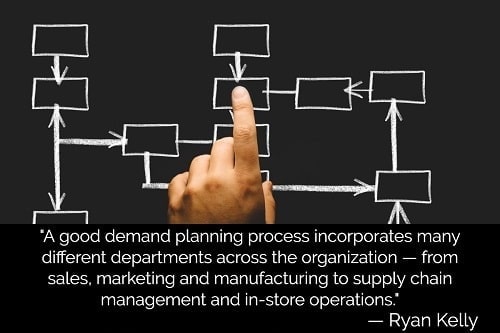
45. For a better customer experience, tighten up your demand planning tactics. “One way to alleviate the pressures of modal selection is through demand planning. A good demand planning process incorporates many different departments across the organization — from sales, marketing and manufacturing to supply chain management and in-store operations. To make informed decisions regarding demand, organizations should also have a warehouse management system (WMS) in place for aggregating data and providing predictive analytics. Adding qualitative data from across the company can then help put your predictive analytics in context – supporting your plan for demand at a very granular level.” — Ryan Kelly, How Inbound Logistics Impacts the Customer Experience, FedEx Supply Chain; Twitter: @fedex
46. Be generous to your customers, and make sure you can deliver on your promises. “If you are an e-commerce merchant, your supply chain might stretch thousands of miles. But these days, all eyes seem to be trained on the final stretch of that journey from the point of manufacture to the customer’s hands. Retailers and their service providers are applying a range of strategies to deploy the last mile of e-commerce fulfillment to win consumers’ hearts and minds.
“The theory is that if you make the experience pleasant, provide lots of information, offer special services and maybe turn the product’s arrival into a mini-celebration, customers will keep coming back for more.” — The Customer Experience: The Last Mile Gets the Royal Treatment, Inbound Logistics; Twitter: @ILMagazine

47. Don’t be afraid to ask for feedback. “We all dislike emails that have no business in our inboxes. Moreover, we do not really enjoy email surveys — they are long and time-consuming. One way to receive timely feedback is to get customers to participate in quick, SMS-based surveys that they can finish in a heartbeat.
“We all have our mobile phones on hand every second of the day, and SMSes have high open rates. Studies have also shown that by sending SMS surveys, the response rate is significantly higher than email surveys — 51% to 43% respectively. Imagine gaining valuable customer feedback right after their packages are delivered — it’s a win-win situation!” — Wavecell, 5 Things Logistics Companies Should Do to Boost Customer Experience, Medium; Twitter: @Wavecell
48. Invest in technology that triggers automated communication with the customer. “Another recent innovation being adopted by retailers is to use despatch scans in the warehouse to trigger messaging to the consumer. As a product leaves, the consumer is connected with the start of its journey, and then has visibility of its progress through the tracking mechanism on the retailer’s website so that they know exactly where it is and when it will arrive at its destination. Underpinning these advances, is technology that has been designed not only to enhance operational efficiency but to extend that to improve the experience of the customer.” — Kees de Vos, Chief Product & Marketing Officer at MetaPack, Bridging Logistics Efficiency with Customer Experience, ITProPortal; Twitter: @ITProPortal

49. Invest in a tailored mobility solution. “To reduce the delivery time and in order to enhance the customer experience, enterprises must focus on adopting the right mobility solution that aids in running their field operations seamlessly. For example, Last -mile deliveries in the region are time-consuming with the delivery cycle easily lasting for 6 to 7 days or more. The longer delivery window poses a challenge for the delivery personnel to carry the details of each and every parcel delivery.
“With the help of mobility solution, that functions in 2G networks or even offline mode, the delivery personnel can save the information and update his manager ‘real-time.’ Adopting a flexible and future-oriented solution helps in generating automated reports on cash reconciliation, updating the task lists and the progress of the jobs allotted after the run-sheet is generated.” — Kushal Nahata, Logistics Must Adapt to New Age Digital Technologies to Transform the ‘Digitally-Empowered’ Customer Experience, Forbes Middle East; Twitter: @ForbesME
50. Consider investing in augmented reality technologies. “Augmented reality is another innovation that our retail and e-commerce customers can offer to consumers, providing more control over the shopping experience. The technology creates a virtual image of how an item will look in a given room, dramatically decreasing the likelihood of returns. Augmented reality enhances the efficiency of the entire last mile process, reducing time inside the home and the risk of product damage.” — Troy Cooper, President of GXO Logistics as told to Brian Straight, GXO Logistics Turns to Augmented Reality to Boost Last-Mile Customer Experience, Freight Waves; Twitter: @FreightWaves
Interested in more? Let’s discuss the solution that’s right for you. Contact us today.

